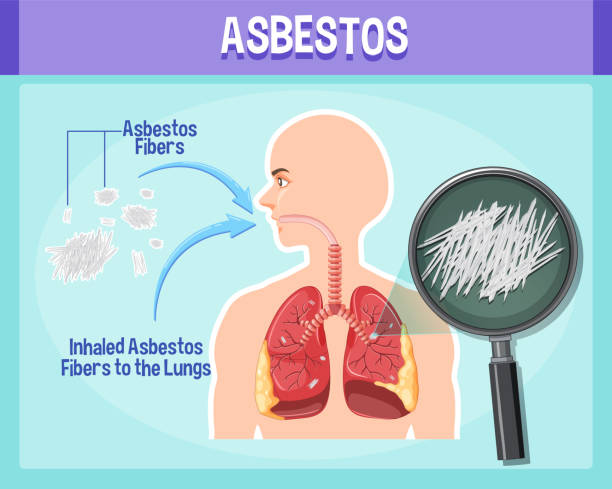However, inhaling asbestos fibers can lead to serious asbestos-related diseases, including asbestosis, lung cancer, and mesothelioma, but these conditions develop over many years of exposure and do not produce immediate symptoms in the throat.
How Does Asbestosis Affect Your Throat?

Asbestosis itself does not directly affect the throat. The condition primarily impacts the lungs through scarring and reduced elasticity, which affects breathing capacity.
Any throat symptoms associated with asbestosis would be indirect, such as a dry cough that can cause throat irritation over time due to frequent coughing.
The primary effects and symptoms of asbestosis are respiratory, focusing on lung function rather than throat health.
How Long Does It Take For Asbestosis To Affect You?
The development of asbestosis typically requires prolonged exposure to asbestos materials, and symptoms can appear anywhere from 10 to 40 years after initial exposure.
The severity and onset of the disease depend on the duration and intensity of asbestos exposure, as well as individual factors such as a person’s overall health and smoking history.
Common Symptoms Of Asbestosis

Common symptoms of asbestos exposure include:
Shortness of Breath
Initially occurs only with exertion but can become more constant as the disease progresses. This happens because scar tissue in the lungs reduces their elasticity, making it harder for them to expand and contract.
Persistent Dry Cough
This symptom is a result of irritation and damage within the lung tissue. The cough is usually dry, meaning it doesn’t produce mucus, and it persists over a long period.
Chest Tightness or Breathing Chest Pain
Fibrosis of the lung tissue can cause a sensation of tightness in the chest, sometimes accompanied by pain. This is due to the lungs being restricted and stiffened by scar tissue.
Clubbing of Fingers and Toes
Occurs in more advanced stages of the disease. Clubbing involves changes in the areas under the fingernails and toenails, leading to swelling and a bulbous appearance. It is associated with chronic low oxygen levels in the blood.
Crackling Sound
When a doctor listens to the lungs with a stethoscope, they may hear a fine crackling sound at the end of inhalation.
This sound, known as end-inspiratory crackles, is characteristic of pulmonary fibrosis, including asbestosis.
How To Manage Asbestosis Symptoms

Managing asbestosis symptoms involves several approaches:
- Pulmonary Rehabilitation: Programs designed to improve lung function through exercise and education, helping patients manage breathlessness and increase activity levels.
- Oxygen Therapy: Used in more severe cases to help alleviate shortness of breath and maintain adequate oxygen levels in the bloodstream.
- Medications: Inhalers may be prescribed to open airways or treat secondary conditions like chronic obstructive pulmonary disease (COPD). Corticosteroids or other anti-inflammatory drugs can also be used to reduce inflammation.
- Regular Monitoring: Regular check-ups with a healthcare provider to monitor lung function and manage any complications.
- Lifestyle Changes: Quitting smoking is crucial as smoking can exacerbate symptoms and accelerate the progression of lung damage. Additionally, patients are advised to maintain a healthy diet and avoid further exposure to lung irritants.
- Vaccinations: Recommended to prevent lung infections, such as influenza and pneumonia, which can worsen the condition.
These measures do not cure an asbestos-related disease but can help relieve symptoms and improve quality of life.

